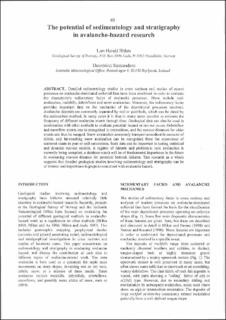The potential of sedimentology and stratigraphy in avalanche-hazard research
Chapter
Permanent lenke
https://hdl.handle.net/11250/3082548Utgivelsesdato
1998Metadata
Vis full innførselSamlinger
- NGI articles [1061]
Sammendrag
Detailed sedimentology studies in cross sections and studies of recent processes on avalanche-dominated colluvial fans have been combined in order to evaluate the characteristic sedimentary facies of avalanche processes. These include rock avalanches, rockfalls, debrisflows and snow avalanches. Moreover, the sedimentary facies provides important data on the mechanics of the depositional processes involved. Avalanche deposits are commonly separated by soil or peat beds, which can be dated by the radiocarbon method. In many cases it is thus in many cases possible to estimate the frequency of different avalanche events through time. Geological data can also be used in combination with other methods to evaluate potential impact or run-out zones. Debrisflow and snowflow events can be recognised in excavations, and the run-out distances for older events can thus be mapped. Snow avalanches commonly transport considerable amounts of debris, and far-reaching snow avalanches can be recognised from the occurrence of scattered clasts in peat or soil successions. Such data can be important in testing statistical and dynamic run-out models. A register of historic and prehistoric rock avalanches is currently being compiled, a database which will be of fundamental importance in the future in evaluating run-out distance for potential bedrock failures. This research as a whole suggests that detailed geological studies involving sedimentology and stratigraphy can be of interest and importance in projects concerned with avalanche hazard.
